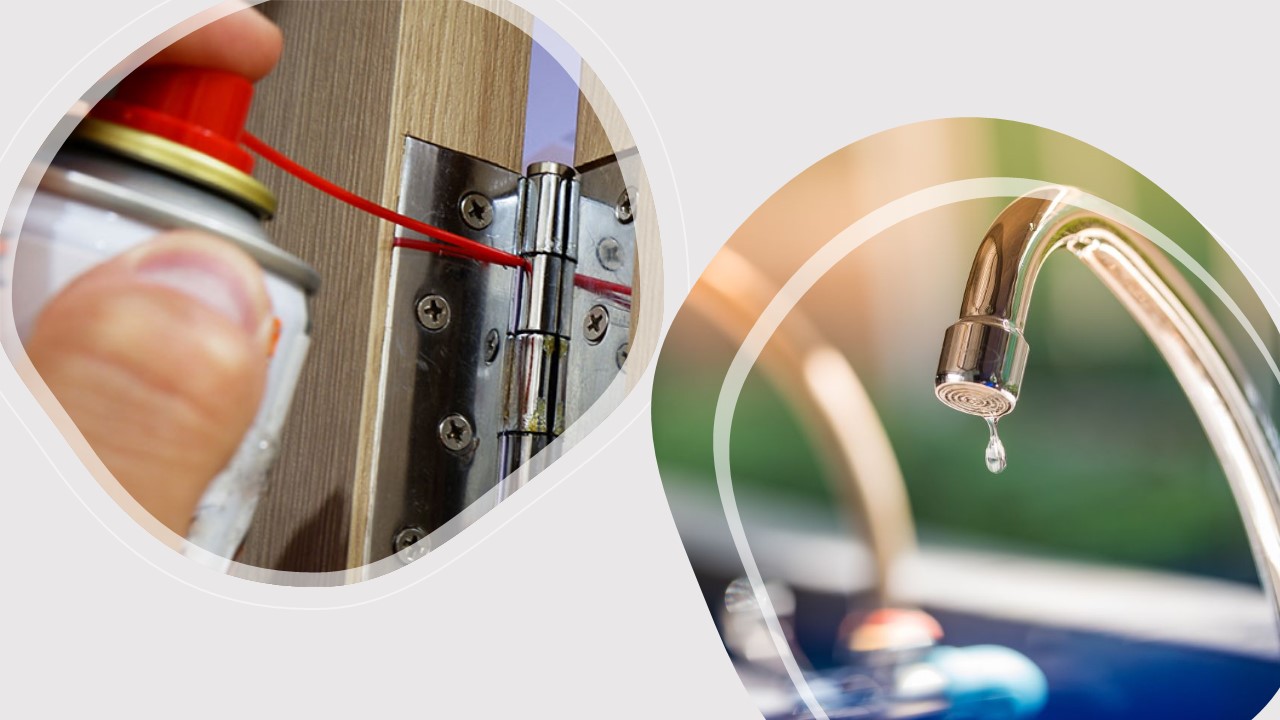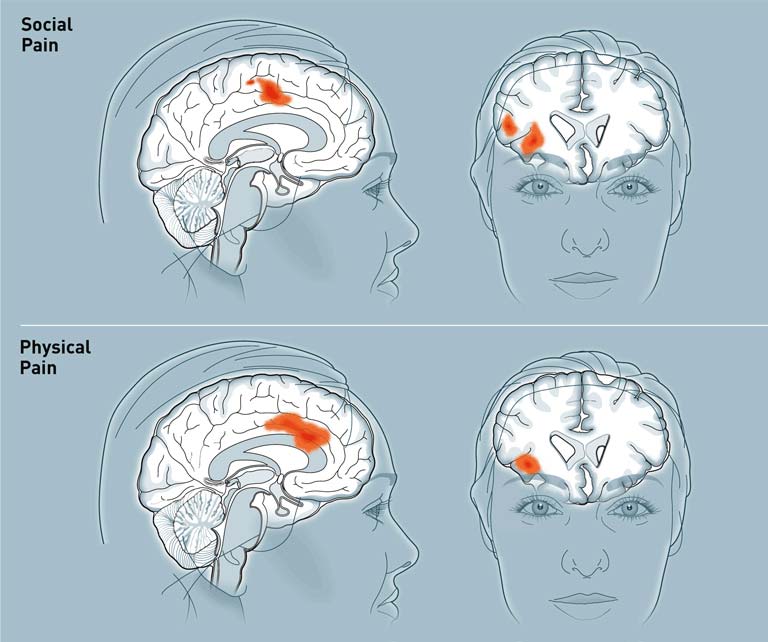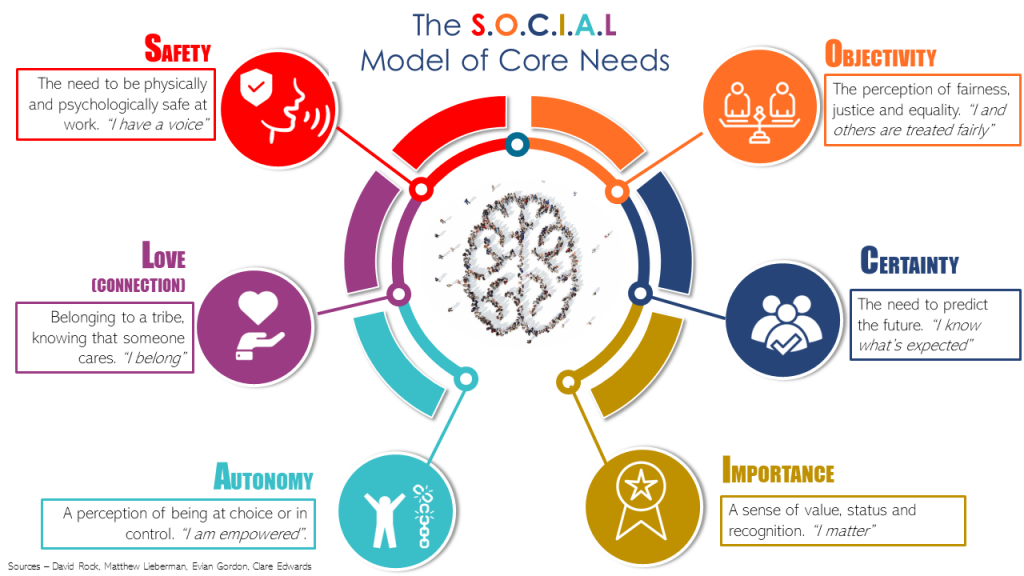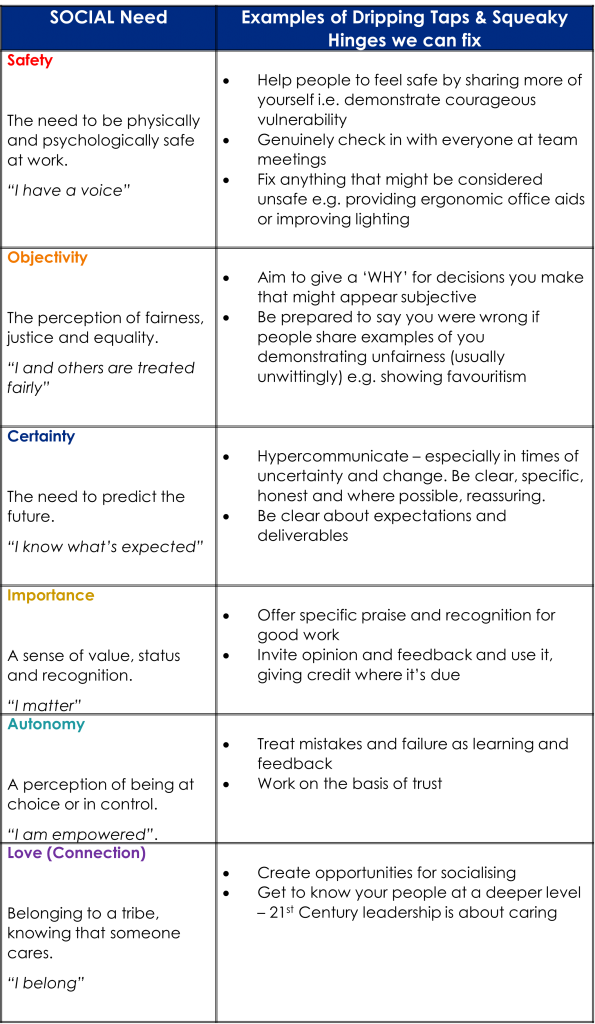
Introduction
This article outlines key insights about the brain that drive our behaviour and our reactions to situations where we might feel under threat and therefore under-perform. It also presents a model that can help leaders, managers and co-workers minimise social threats and maximise rewards for themselves and others, so that they can function well and be engaged and productive at work.
Dripping taps and squeaky hinges are metaphors for the ‘niggles’ that you might be presented with from people at work (and risk ignoring), that in reality are a set of core needs that are not being fulfilled.
Understanding the Brain to lead your People well.
Back in 1944 lyricist Johnny Mercer told us “You’ve got to accentuate the positive, eliminate the negative” and how right he was, just in the wrong order! Our brains are biased towards the negative, scanning our environment (unconsciously) 5 times per second for potential threats.
While we might never be able to eliminate the negative, we can certainly minimise it.
Bad is Stronger than Good – Our Brain’s Negativity Bias
“The brain is like Velcro for negative experiences and Teflon for positive ones.”
Rick Hanson
It makes sense that we would have a bias towards negativity; it’s what kept us alive as the earliest humans. When we were out roaming the African Savannah plains, we were either looking for lunch or being lunch; it didn’t serve us to be admiring a pretty sunset – that got us eaten!
Still today, we have 5 times more neurons in our brain dedicated to scanning for danger1 and keeping us safe2, than looking for pleasure or reward. You don’t have to look far to see this default in action – simple acts like hearing someone say, “Can I see you in my office please?” or “Can I give you some feedback?” can have us running for the hills!
Why being rejected can feel like a Kick in the Stomach
In 2012 Social Cognitive Neuroscientist Naomi Eisenberger3 identified that the areas of the brain activated when we experience physical pain are almost identical to the areas activated when we experience social pain, examples of social pain being rejection, shame, abandonment, loss, embarrassment etc.
One key difference is that, with social pain, the memory of it lasts for longer and goes deeper. Think back to when you last had a physical injury and recall it, now think back to the last memory of a relationship break up or loss of a loved one and recall that. This is why being rejected can hurt more than a kick in the stomach.
We are often unaware of the potential for causing social pain at work. For example, we might inadvertently offer someone a place on a project team and not see the impact on the other person who was praying that they would be the one chosen, or we might think that we’re empowering someone by delegating a task that we haven’t fully briefed them on, and the result for them is paralysis, fear of looking incompetent and embarrassment that causes them to freeze and retreat or worse still, leave.

Naomi Eisenberger estimates an approximate 95% overlap between social and physical pain in the brain
Eliminate the Negative to accentuate the Positive
Because we default to the negative, we need balance things out with a strong focus on the positive (Positive psychologist Barbara Fredrickson suggests a ratio of about 3 positives to 1 negative though this isn’t scientific).
But here’s the secret sauce; because we have multiple brain networks actively scanning our environment and dedicated to seeking to avoid danger and pain, fixing what’s not working is a positive because it minimises the threat!
So in essence, when we fix what’s not working, or look to fulfil a need that someone has, it helps to restore balance in our brain and we find ourselves less in a ‘threat’ mode and more in a ‘safe’ or ‘reward’ mode. This is good news because in ‘threat’ mode, we can’t think clearly, make good decisions, be creative and the list goes on. All of these traits are what we don’t need in people when we want them to be productive, engaged and happy!
A Model to help identify Squeaky Hinges and Dripping Taps
You may be familiar with David Rock’s SCARF model. Based on the works of Eisenberger and Social Cognitive Neuroscientist Matthew Lieberman, Rock identified 5 domains of experience that, when challenged, withheld or absent, can put us into a threat state and, when fulfilled or acted upon, can put us into a reward state.
SCARF is an acronym for Status, Certainty, Autonomy, Relatedness* and Fairness.
*I took this model and adapted it because I felt that ‘relatedness’ – ‘feeling safe with others’ warranted separating to 2 individual elements – 1. Safety (both physical and psychological) and 2. Love (Connection) – that feeling of belonging to a tribe.
The SOCIAL Model of Core Needs
Welcome to SOCIAL – a model of core needs and motivators that we can use as a framework to deepen our understanding of ourselves and others and create environments for these needs to be met (and hinges and taps fixed!). S.O.C.I.A.L is an acronym for 6 core needs that everyone has in a unique ‘point in time’ hierarchy. We are the most social species on the planet, our brains are social organs and we all have these six core needs to differing degrees, that need to be fulfilled in order to flourish and thrive.

A Hierarchy of Needs
Each of us has a ‘point in time’ hierarchy of SOCIAL needs and as leaders, when we understand the needs of our people at this level, we have the ability to motivate and lead them by helping to fix what’s not working or coach to find solutions.
For example, if a reorganisation is announced, certainty may well rise higher, or if bullying has been identified, for those involved, it could be safety.
The ‘dripping taps’ and ‘squeaky hinges’ analogies is to point to the fact that many people aren’t consciously aware of what they need and so can be negative and complain without knowing what’s really driving their behaviour.
It might be that their needs are being partially or inconsistently met or are met with some people and not others, so the more we can identify opportunities to help people fulfil their needs, the greater the win:win all round.
How Issues can Present Themselves
Whereas a dripping tap or squeaky hinge is obvious to see or hear, your peoples’ needs may be a little more subtle and will often present themselves as quibbles, gripes, complaints and moans.
Examples include (but are most definitely not limited to!)
Safety – “I don’t feel like I’m being heard”
Objectivity – “I never get chosen for the special projects team and I’m just as good”
Certainty – “I’m always the last to find out what’s going on”
Importance – “I’m getting no credit for my contribution”
Autonomy – “I’m fed up with my decisions being overruled”
Love (Connection) – “My boss doesn’t even know my partner’s name”
Here is a taster of ‘dripping taps’ and ‘squeaky hinges’ that might be troubling and that we have the power to fix!

How you can use and embed the SOCIAL Model into your Organisation
Once you are familiar with SOCIAL at a deeper level, you can use it in a variety of ways and, once embedded, can become a language framework for people talking about what they need, where they’re struggling and deepening their self-awareness and awareness of others.
I have co-created a SOCIAL self-assessment questionnaire that helps people identify their ‘point in time’ hierarchy of needs and this can be extremely helpful in uncovering specific individual and team challenges and opportunities.
Here are some applications for using SOCIAL:-
- As a coaching tool
- As part of a project kick-off
- In induction and onboarding
- As part of a performance management conversation
- For identifying team challenges
- For identifying underlying issues not being divulged
Case Study
I was working with a team that was selling high value software solutions and in one workshop each individual completed a SOCIAL hierarchy self-assessment and plotted their 2 highest needs anonymously on the flip chart.
When I revealed the results, there was an audible gasp. Out of 20 team members and their manager, 15 had ‘Objectivity’ as their top need and the 2nd need was Safety.
With the sales manager’s permission, we held an open and frank discussion about what could be influencing this result. What transpired was that the sales manager was distributing ‘very hot’ leads to certain people, assuming this was on a confidential basis, but the recipients of those leads (for whom Importance was high) divulged what was happening and the team was close to imploding. There was also a lack of psychological safety in speaking up.
The result was a commitment by all to complete openness and transparency and the whole team, 6 months later, was lifted and performing exceptionally well.
Conclusion
As leaders and people managers, we can never get it right 100% of the time, ours is a continual ‘work in progress’. When we invest the time and energy to understand that the quibbles, gripes, complaints and moans might be a need not met or a call for help, we are better equipped to take action to address them i.e. fix those dripping taps and squeaky hinges, and we can be rewarded for helping lift the quality of life and work experience for all.
A small caveat – I’m not saying that we don’t need to be discerning about those who might be swinging the lead! Performance always needs to be managed.
If you would like to find out more about the SOCIAL model and how it can be used in your organisation, please get in touch.
1 (Baumeister 2001) ‘Bad is Stronger than Good.
2 (Gordon 2000) The key organising principle of the brain is to minimise danger and maximise reward
3 (Eisenberger 2012) The Neural Bases of Social Pain. Evidence for Shared Representations with Physical Pain
Leave a Reply